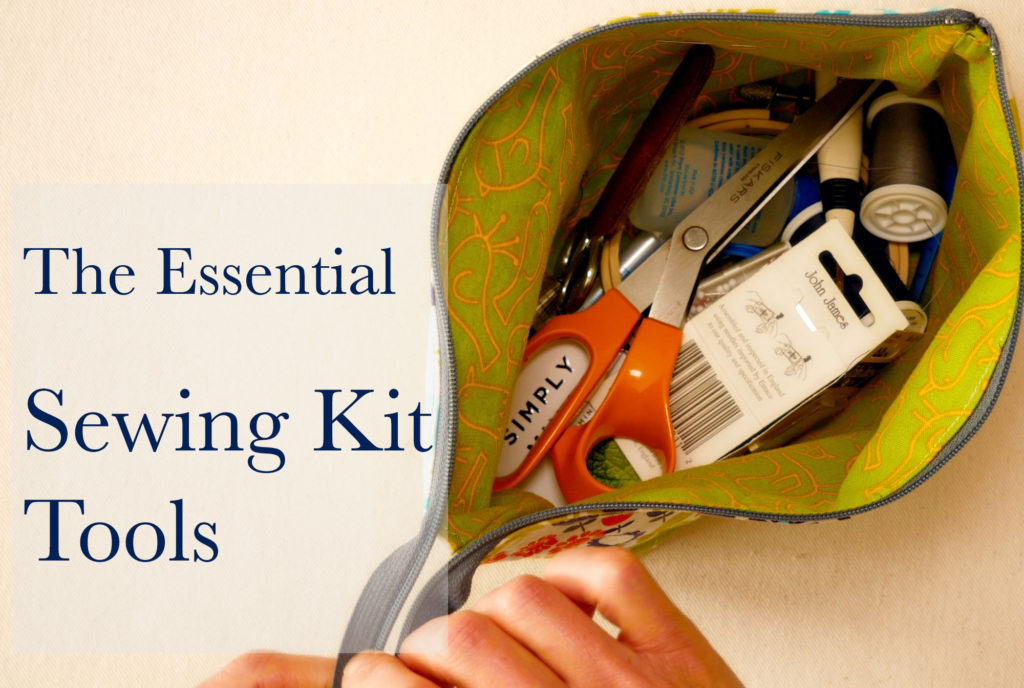
If you’re new to sewing and you want to mend your clothes and do some simple alterations or projects, what sewing tools do you need? I mean what do you REALLY need?
Well, it isn’t much and you don’t need a sewing machine. Not yet. If you discover that you like sewing and want to sew bigger projects then you should buy one.
But for mending or simple projects you actually only need 6 things which I’ll go through here in detail. The main thing is you really don’t want cheaply made tools. They will make your sewing task frustrating and take twice as long. However, this doesn’t mean you need expensive tools either, just well-made tools.
So If you want to shorten a dress, mend a small hole, or secure a button here are the sewing tools you’ll need and some additional items you may want to have in your sewing kit.
This post contains affiliate links to products I use. Products I have bought with my own $. If you use these links a very small percentage of the sale comes back to me. Which is nice
The Six Essential Sewing Tools Any Person Needs to Have
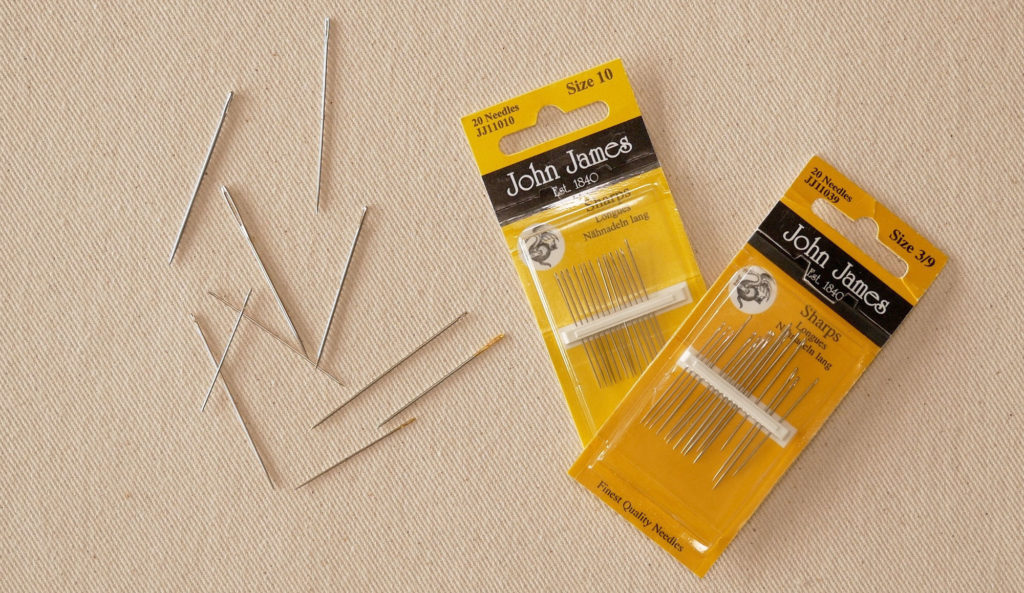
Needles
It’s a needle, not a harpoon my professor used to always tell us. He meant you want a needle strong enough for the fabric you are sewing but slim enough to glide through your fabric. You will notice that needles come in a huge variety of types. For general garment sewing and repairing get a pack of “sharps” in an assortment of sizes, Size 3-9 will cover most jobs. Try to follow my professor’s advice of using the smallest needle for the job. It will make your task easier.
Replace your needles after a lot of sewing as they will become dull. Did you know that the “strawberry” attached to the classic tomato pin cushion is for sharpening needles? Yes, it is. Just poke the needle in the strawberry a few times to sharpen it up a bit.
Most needle packs will also store your needles safely so keep the packaging intact when you first open them up.
My Favorite Needles are John James Needles I’ve been using them since college – which means, a long time now.
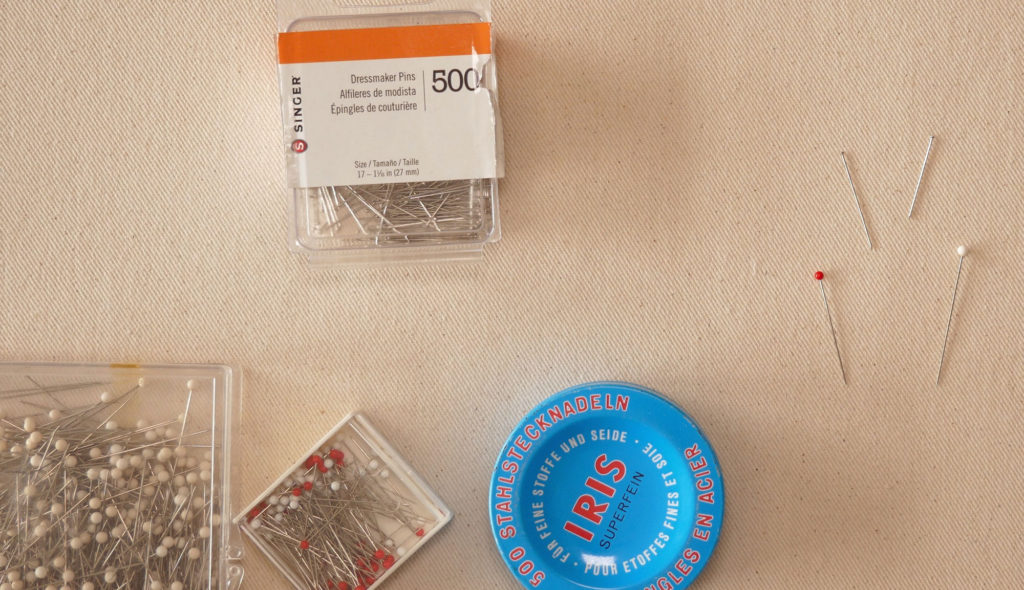
Straight Pins
Pins are like extra fingers. They hold the fabric in place as you sew, they help you determine and mark how much you want to take in or shorten a garment, and they can mark any specific point on a garment without leaving a mark, like where you want to place a patch or trim.
Pins, like needles, come in a variety of lengths and thicknesses for different types of fabric and tasks. A basic sewing kit needs just one type of pins, I recommend thinner pins (Usually referred to as “fine” or “dressmaker” pins). Fine pins are slim enough to not leave holes in delicate fabrics like silk, rayon, or knits but can still be used on heavy fabrics like jeans.
And you don’t need a large pack of pins. A couple of dozen is plenty if you can “borrow” some from a friend who sews. If your pins don’t come in their own storage container you could use a small tin, like mints come in, or box. pill bottles, small plastic storage containers, and a piece of fabric with your pins stuck in it will also work as does a pincushion. Just check that your container securely shuts.
Some folks will tell you to buy glass-head pins. The head is the stumpy end of the pin. Large pinheads help separate the pins making them easier to pick up. They also make it easier to see your pins in your project or on the floor where some always manage to go. Glass-head pins can be ironed over without melting but a plastic pinhead will melt. That said, what type of head your pin has doesn’t change its function. So use what you want.
My Favorite Pins are Iris Super Fine pins but they are hard to find in the States and expensive. So now I buy Clover Brand pins and I must admit they are pretty great.
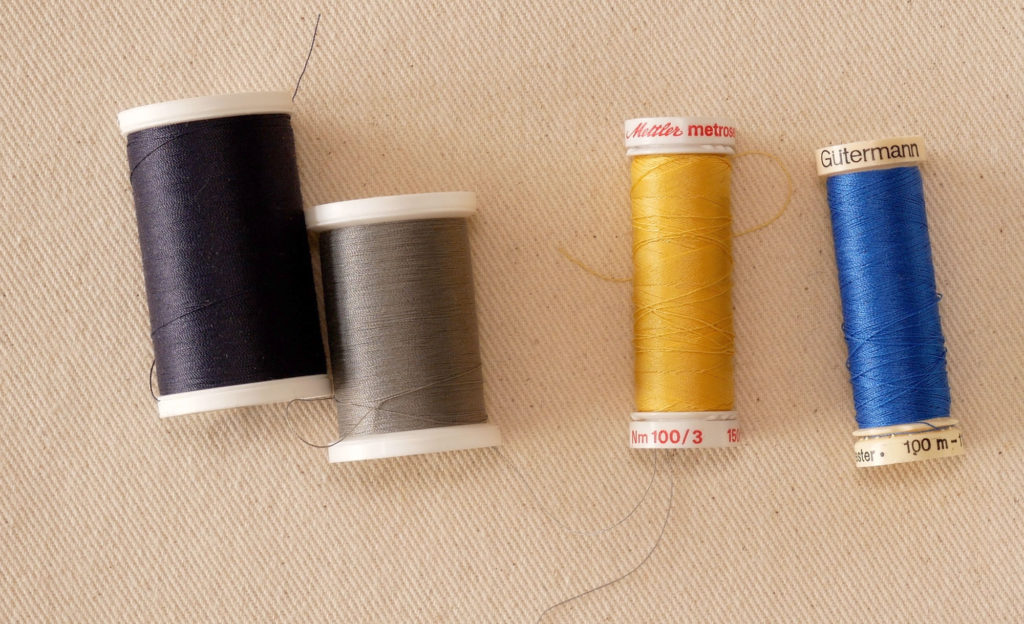
Thread
You will be surprised how drastically the quality of your thread impacts your sewing job. Cheap thread tangles and knots on itself and breaks. It will not save you money. It will waste your time. You will curse it.
Buy a couple of spools of “all-purpose” or “general purpose” thread in neutral colors (say black and white) or in the colors you wear a lot of. When taking garments in and repairing seams your thread will not show on the outside of the garment. When applying patches, buttons, and trims it probably will but I would wait until you have that project in hand before you buy thread you may never need.
When your thread will show you’ll want to match the thread to the fabric as best you can. A good tip to remember is that darker colors always blend into the background better than lighter colors. When sewing buttons, the thread can match the button, the fabric, or be your favorite color (consider it your “signature”).
All-purpose thread is 100% polyester. It’s strong and doesn’t shrink. You will see cotton thread, rayon thread, topstitching thread, button & craft thread, silk finish thread, metallic thread, etc, etc. Any type of thread really could be used but if you are buying thread for your kit, start with all-purpose.
I use and can recommend these three brands of thread but there are other good brands out there; Coats & Clark, Mettler, and Gütermann. And don’t forget to check a second-hand store for spools of thread. Just remember this General Rule: Any thread that comes in a sewing kit, on tiny spools, or on styrofoam spools is cheaply made and therefore use it for emergencies only.
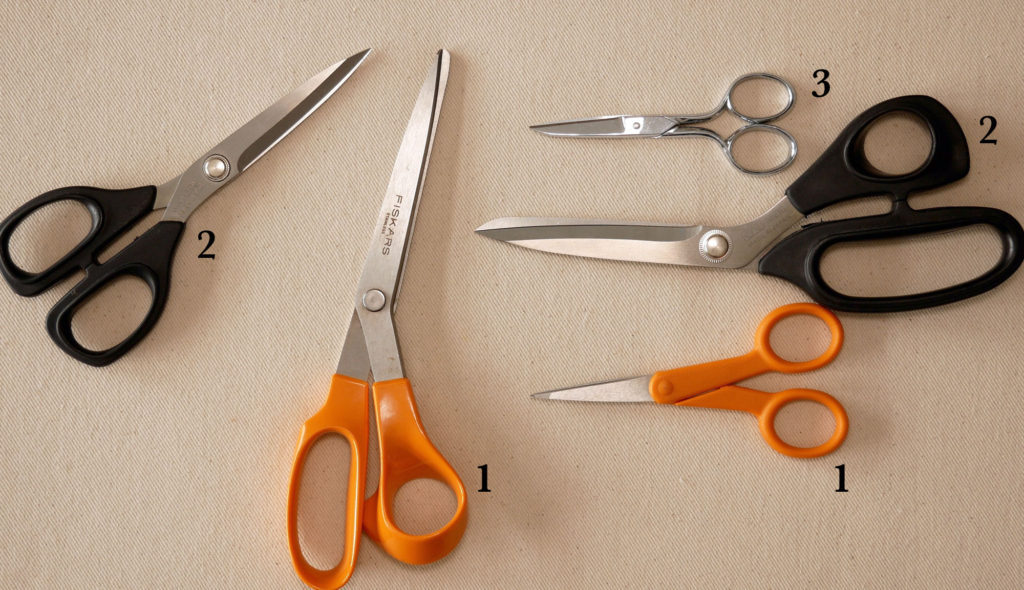
Scissors
The key to a good pair of fabric scissors is that they are sharp. Sharp, not expensive, just sharp. All other features are optional and extra. If you don’t already own a pair of sharp scissors get the classic orange handle Fiskars. The orange handle will remind you, and anyone else in your space, that these scissors are for sewing and not for hard plastic packaging, wires, or toenails.
Most importantly, though, if you’re left-handed, take the time to find a lefthanded pair of scissors. (try Wawak if you can’t find them locally)
Scissors for cutting fabric have a 7 to 12-inch long blade and usually have a bent angle near the handle. This allows the blades to get under the fabric without disrupting the placement of the fabric.
Smaller scissors are great for snipping thread, cutting around small curves (when making a patch), and getting into tight spaces.
I use my medium size scissors a lot. I think of them as a hybrid.
1. Fiskars are great scissors for the money. I still use my 30+-year-old pair. (Don’t be fooled by the cheap imitations you see everywhere)
2. Kai scissors are slightly more pricey but the blades move as smooth as butter.
3. Gingher are great scissors and the price does reflect that. But if you get into sewing you may want to invest in a pair.
I also have a pair of Horn scissors (not pictured) that I think very highly of and never share with anyone. (My Precious)
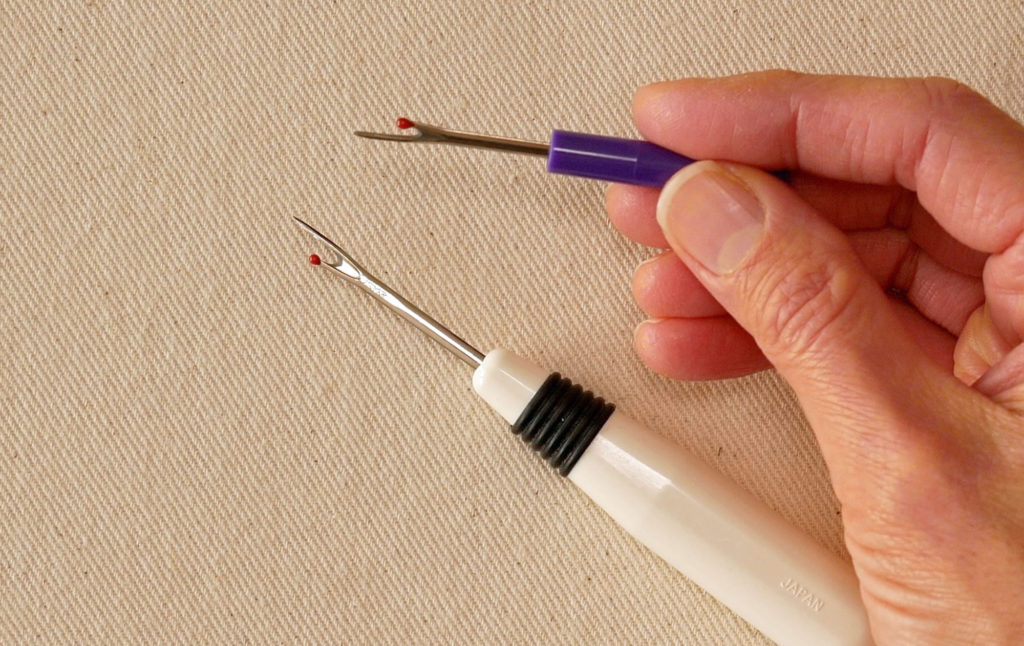
Seam Ripper
Everyone needs a full-size, nice to hold, seam ripper. They’re perfect for removing labels, buttons, mistakes, hems, and seams.
Never use a dull seam ripper. They can slip under the extra force you’ll need to use it and rip your fabric or your hand.
And don’t use a miniature seam ripper unless you have miniature hands. They are awkward to hold and awkward to use. I feel that they are inviting more trouble than they are fixing. If this is all you have please use caution and know you will need a little more time (and patience) to do the job.
All seam rippers may rip your fabric if you are not careful. They can also rip your skin so always work with the ripper end pointing away from you.
My Absolute favorite seam ripper is my current Clover Brand seam ripper, pictured above.
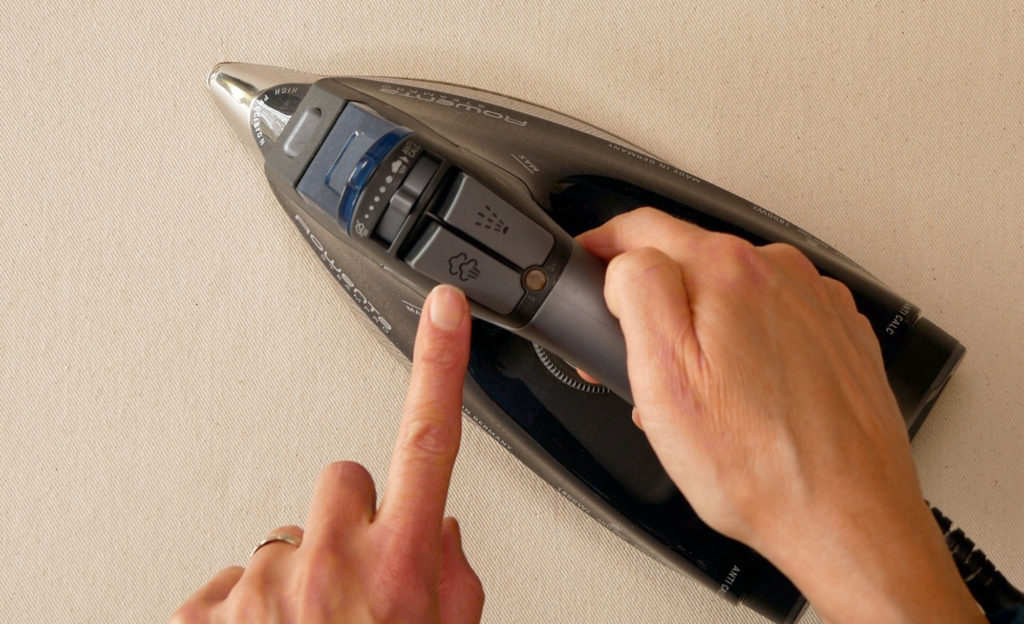
Iron
Not a tool you may think of when it comes to sewing but an iron will elevate your sewing. You’ll need it to press open your new seams when taking in garments, to press a new hem after shortening a garment to set the stitches, for patching, and for preparing the garment to be repaired. Sewing on and cutting out creased fabric gives you crooked seams and choppy edges so press it flat before you begin.
And, you do not need an expensive iron. You just need one that can apply steam. I have a friend who sews all the time, and she uses a very old, very cheap, basic iron. No problems.
You also don’t need an ironing board, although these are super handy when ironing. You could use a folded cotton towel or a couple of them stacked on top of each other (because cotton can handle high heat without melting unlike some other fibers or cotton blends) Of course, it will burn cotton if left on it too long and too still. Never leave your iron on when not in use.
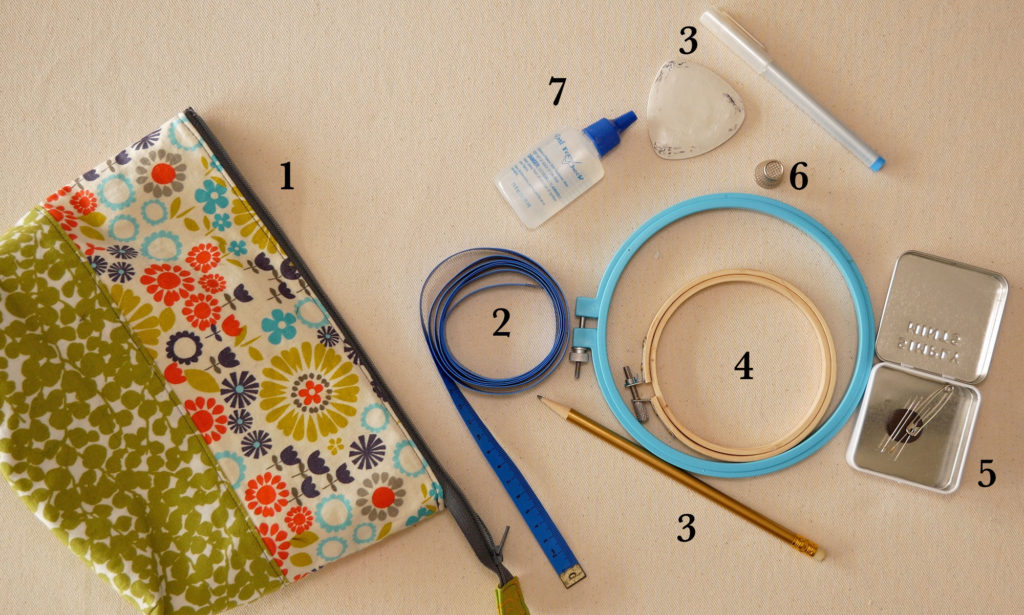
A Few Additional Items That Might Be Handy
1. A box, pouch, or another container to keep all your sewing tools together
2. A ruler or tape measure – One that has inches on one side and centimeters on the other might be helpful (One day we will switch to metric here as I was promised in 1970-something)
3. A pencil, fabric pen, or chalk, to temporarily mark on any fabric or garment. My grandmothers used a sliver of white soap to mark dark fabrics. A lot of the time I use straight pins to mark on my fabric. (I place a pin in the garment where my “mark” is instead of marking that spot with a pencil)
4. A small embroidery hoop can be handy for darning and patching by hand. It holds the area you’re working on taught and in place
5. A safety pin or a few are super useful for fishing cords and elastic through casings; hoodie cords, elastic waistbands, ties, and the like.
A magnet is a great way to keep track of your needles. I put mine in an empty mint tin just to keep the magnet off my scissors.
6. A thimble if you are going to be working with fabrics that are more heavy-duty like denim. A thimble is worn on the middle finger of your dominant hand. It helps you push the needle through the fabric.
Thimbles come in metal, leather, plastic. Find one that fits your finger no matter what it’s made from.
7. Fray Check is a solvent that dries clear and prevents the fabric from fraying. It’s also great to apply a drop to the knot in your thread when sewing on buttons or zippers to be extra certain it will not come undone under the constant pulling buttons and zippers receive.
(Not Pictured) Some extra buttons, snaps, hooks, and eyes. I would wait until I needed one of these items before I buy it but if you see some in a second-hand store (and they aren’t rusty) they could be handy to have in your stash.
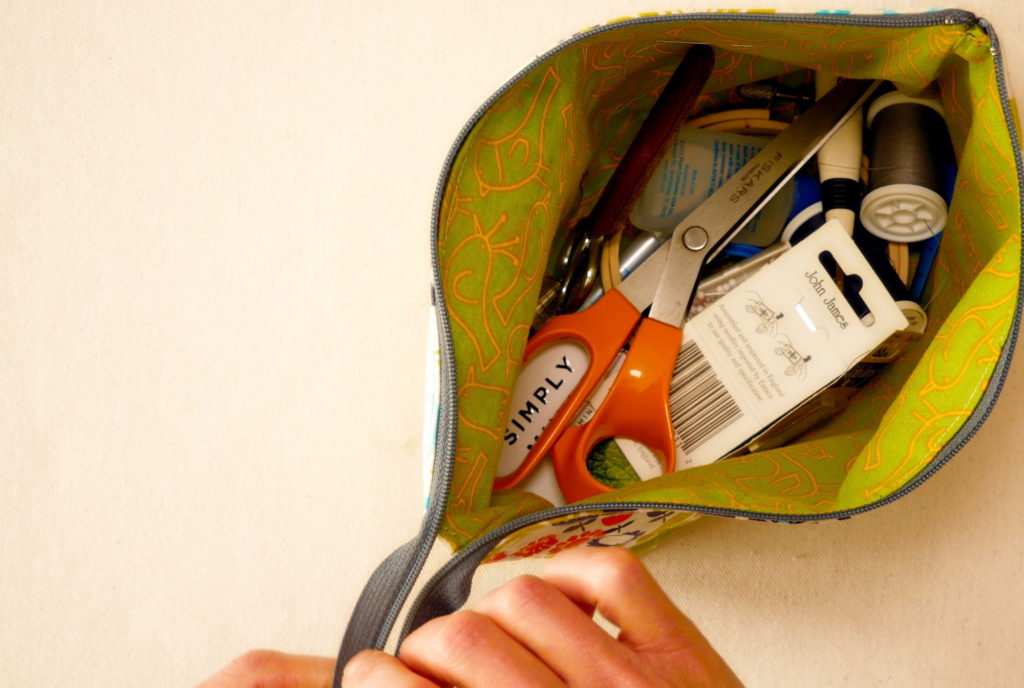
You can find most of these items in any large fabric store or on Amazon. If you are having trouble finding left-handed scissors or a decent seam ripper try Wawak. They have good prices and very good customer service should you need it (I only needed it once in what is now years of shopping from them)
